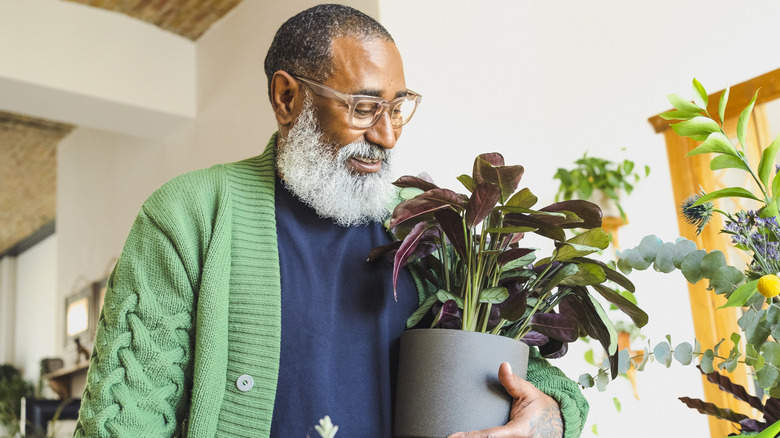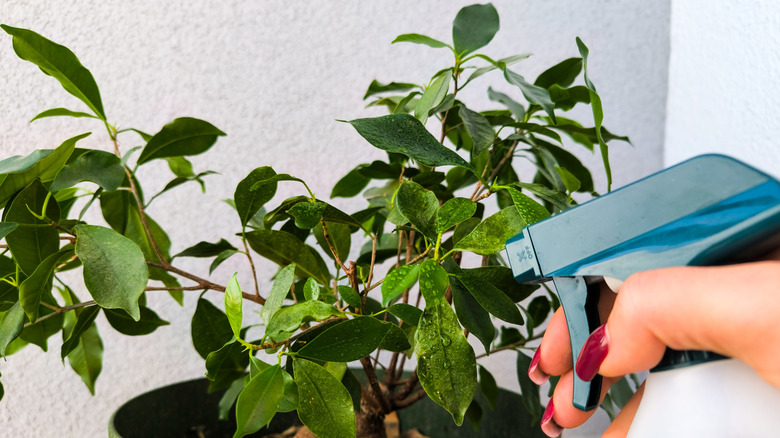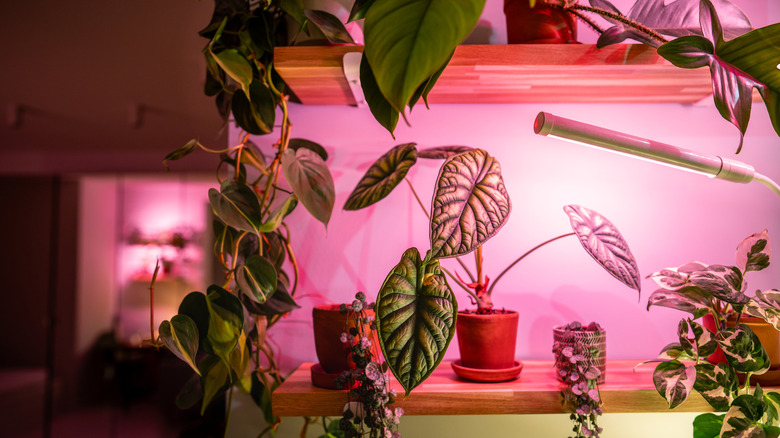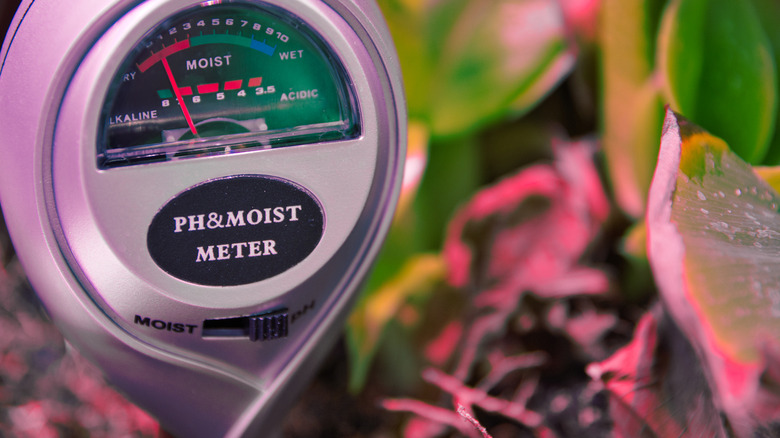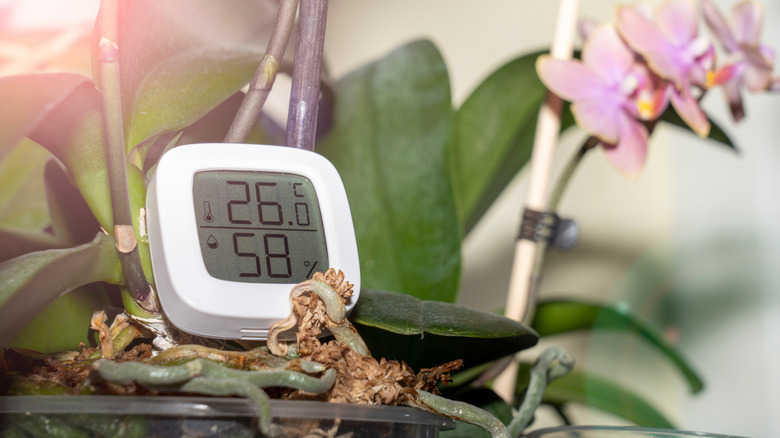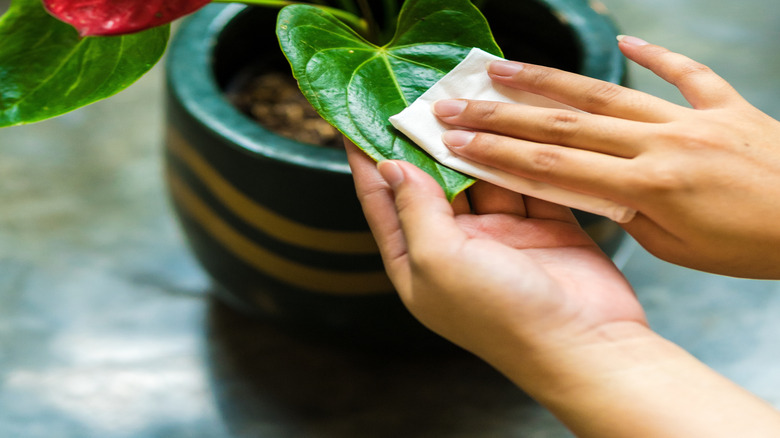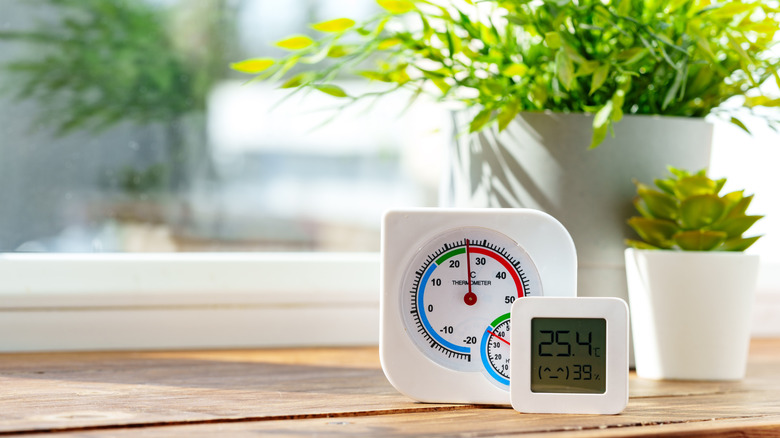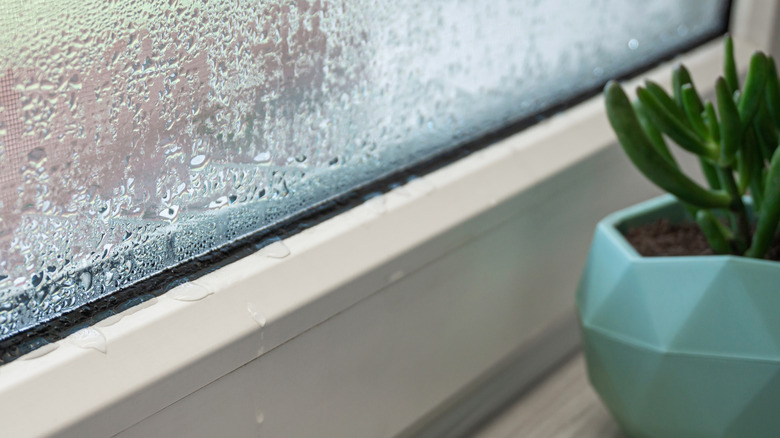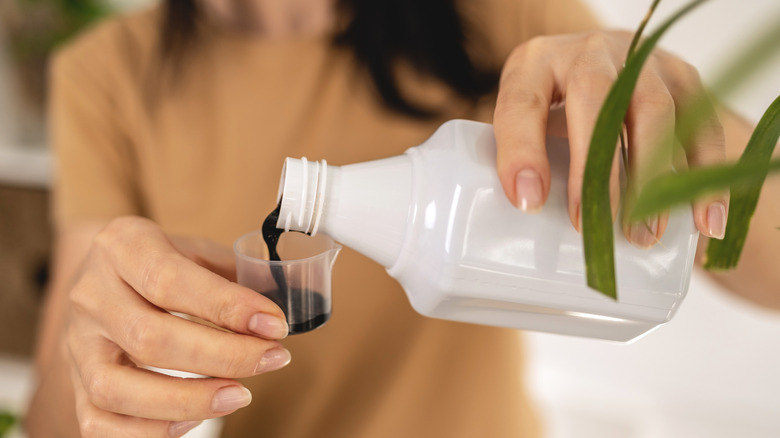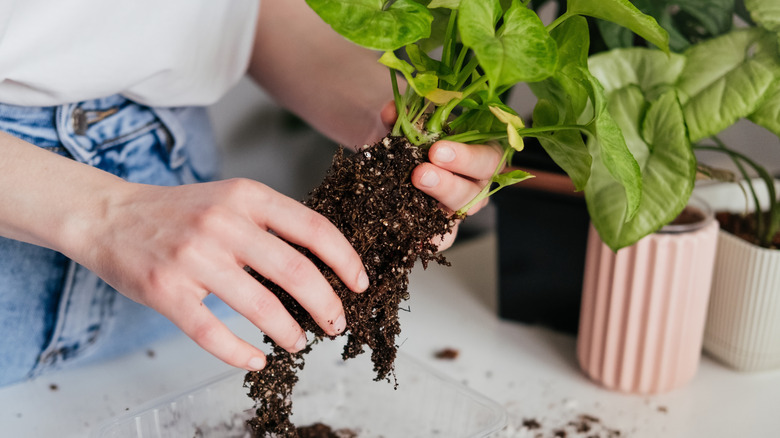How To Settle In Your New Tropical Plant So It Doesn't Just Survive, But Thrive
We may receive a commission on purchases made from links.
So, you brought home a new tropical plant. Maybe it's something bold and dramatic, or maybe it's one of those delicate ones that look like they need a pep talk. Either way, you hopefully did the right thing and gave it a few weeks in quarantine, just in case any uninvited pests came along for the ride. But, now what?
Here's the thing: Tropical plants aren't like your typical low-maintenance succulents. They require you paying attention to the humidity, light, and even where they're sitting in the room, plus they have an upper limit to their tolerance, so you've got to get this just right. The good news? You don't need a greenhouse to keep them happy because there are simple, doable ways to help them settle in and feel at home. That's why we're breaking down 9 practical tips to get them there, plus a few signs to watch for if things start going sideways.
Spray it with a good insecticide
Bringing home a tropical plant means you're also bringing home whatever it picked up on the shop floor, and if it came from a big box store, odds are pretty high that includes spider mites. These pests thrive in warm, dry conditions, which unfortunately, describes both most indoor environments and retail setups. Add in the stress your new plant is already under from adapting to a non-tropical space, and you've got the perfect recipe for trouble. Spraying with a gentle, but effective, insecticide during quarantine can give your plant the reset it needs and boost its health so it can be better equipped for adjusting to its new home. We're big fans of using Earth's Ally 3-in-1 Plant Spray, as it can stop a spider mite infestation before it spirals out of control.
You'll probably notice if things are back on track with your tropical plant: Its leaves will look firm, there's no dusty residue, and the plant seems like it's just chilling, doing its thing. But, if after a week or so something still feels a little off, then go ahead and give it another spray down. It's not exactly thrilling work, but it gets the job done and beats waking up to a fresh wave of webbing. And don't forget to routinely check back in to make sure you didn't miss any eggs or baby pests; it really can feel like a never-ending process, huh?
Slowly adjust its lighting setup from what it had to what it needs
If your tropical plant came from a nursery, store shelf, or a shipping box, chances are it hasn't seen real sunlight in a while. Even plants that need bright, direct light weren't getting it before you brought them home, because many garden centers use filtered light, fluorescent bulbs, or stick plants under shelving. So, bringing it home and immediately tossing your new tropical into a sunny south-facing window is like putting them in a tanning booth and cranking it all the way up. The plant needs time to adjust to its new environment.
Most tropical plants need a bit of a light detox first, so start them off somewhere like behind a sheer curtain or a few feet back from a window. Give it a few days, then shift the plant closer if it's one that prefers stronger sun. Then give it a little more time and keep an eye on things. The color might look a bit richer than it did, or the stems might not seem quite as floppy. Maybe a tiny new leaf shows up. The changes that show you it's settling in will be small, but still let you know things are heading in the right direction.
Check its soil moisture before giving it water
When a new tropical plant arrives, the instinct is usually to water it right away. And while that's totally understandable, it's not always the right move and is a watering mistake that can kill your plants. Some show up sopping wet and another douse of water will kill the roots, while others look like they haven't had a drink of water in weeks. Either way, you need to figure out what you're working with and go from there to give your new plant what it actually needs.
If you want a little reassurance, use a moisture meter to get an accurate reading, like this XLUX Soil Moisture Sensor Meter Water Monitor. These work by using their sensitive probes to determine moisture levels in soil and adjusting the dial accordingly, giving you a good idea of whether your plant's soil is dry or waterlogged. But, you can also just press your finger into the soil a couple inches down. If it feels damp, leave it alone, but if the soil's bone dry and pulling away from the edges, odds are it's become hydrophobic to the point that the soil has compacted too tightly to let moisture in and water will just spill out of the drainage holes. To get things back to normal, you might need to water it from the bottom so that the soil has time to get rehydrated. Just remember to discard any leftover water after a few minutes or you might end up on the other side of the spectrum and have to deal with root rot.
Make sure you have enough humidity around it
While there are houseplants that thrive in dry climates, tropical plants do not. Tropicals are used to air that feels thick from the humidity, so imagine the shock when they're suddenly stuck in a dry apartment. Not great. They've already got enough going on trying to get used to new light, soil, and temperatures, so they're going to need a little help here. Humidity helps plants by keeping the stomata — the tiny pores on the leaves that open to take in carbon dioxide for photosynthesis – nice and hydrated with water vapor. The healthier the stomata, the easier it is for the plant to photosynthesize. If the leaves are dry, the stomata are affected and the plant gets seriously stressed, because it essentially can't breathe.
Most tropical houseplants need about 60% to 80% humidity. Luckily, you don't need to get fancy to up the humidity. Start by using a hygrometer to actually see what your home's humidity levels look like. This ThermoPro TP50 Digital Hygrometer Humidity Gauge with Temperature Monitor is pretty reasonably priced and small enough to fit next to your plant's pot. Next, try tucking the plant somewhere that isn't drafty or bone dry. If the air feels dry to you, it probably feels worse to the plant. And if its leaves start curling or crisping or just dropping like it's throwing a fit, then that's your hint things are getting dire. Your next options are either investing in a humidifier — you can do a desktop one like this SmartDevil Mini Desk Humidifier or go for a whole room one, like this KZF 9L Humidifier. Or, if your budget is a little tight, just group more plants around it to raise the humidity in their little microclimate.
Dusting its leaves may help it settle in faster
Dust seems harmless, but on a tropical plant, it makes staying healthy more difficult. Those tiny dust particles clog the stomata, stopping light and air from getting through. When those little pores on the leaves can't breathe like they should, the airflow gets messed up, and the plant struggles to make the energy needed to thrive. Suddenly it's working twice as hard just to do the basics and when it's the new kid on the block trying to settle in, its stress levels are already high.
You can easily clean dusty houseplants with cotton cloves, a damp cloth, or a soft paintbrush if the leaves are thin or textured. Your dusting routine doesn't need to be perfect, it just needs to be enough to clear off whatever's settled on there. When the surface is clean, light can hit properly, and the plant doesn't have to fight so hard. It'll start to look a little stronger once that stress is out of the way and a little regular dusting will prevent any pest eggs from sticking to the plant.
Place it somewhere that replicates its native temperature range
Tropical plants don't love surprises. A new spot with cold drafts or sudden blasts of hot air from a vent — it all adds up fast. Even if the light and watering seem fine, accidentally putting your plant somewhere where temperatures below 60 degrees Fahrenheit will throw the plant's whole system off due to stress. And unfortunately, you might not even realize what the problem is until leaves start looking weird or dropping.
Instead, try putting it somewhere that stays warm and steady. Not right by a window that leaks cold air, and definitely not next to a vent blowing dry heat all day. If you're the type who likes to crack a window now and then, maybe shift the plant a bit further away. It doesn't need tropical vacation vibes, but if the temperature stays mostly stable, your plant's got a better shot at actually settling in and acclimating to your home.
Make sure there aren't any drafts nearby
Drafts are sneaky. You don't always feel them unless you're standing in the exact spot, but your plant will. That little stream of cold or hot air coming from a door, window, fan, or vent are some of the worst spots for indoor plants, because they can mess with its internal rhythm. Plants hate that kind of air chaos when they're still figuring things out. If the breeze keeps changing, it messes with them. You might not see anything right away, but growth slows down. Or just ... doesn't happen. One day it's fine, but the next it could be dropping leaves like it's officially over everything.
So, before you settle your plant into its new spot, take a minute to check what's around it. If there's a heat vent on one side or a chilly window just behind it, opt for some place a little more stable. Even a fan going nearby all day can dry things out before you realize it. If you're in a tight spot and don't have a better place to put it, there are ways you can stop drafts in your house. Magnetic thermal door covers are awesome for preventing cold drafts, or you can DIY a draft stopper using old socks.
Hold off on fertilizing for a bit if you bought the tropical plant in the winter
It's tempting to give your new plant a boost of fertilizer right away, but if it's the middle of winter, hold that thought. Most tropical plants naturally slow way down in colder months and are mostly just hanging out, waiting for better weather — and this is especially true for houseplants. Most likely you won't see new leaves, and there's not much happening under the soil either, so they're not really looking for a nutrient boost. In fact, it can backfire to where you'll end up stressing the plant when it's already trying to figure out what's going on in its new spot.
Now, if you've got a plant that's already throwing out new growth and you're somewhere that still gets decent light this time of year, you can feed it a little. Just go slow and start with a balanced fertilizer that's diluted to around half strength. And definitely don't add anything if the soil's bone dry, because it'll just pour out of the drainage holes, wasting your effort and plant budget, and it could also burn the roots.
Wait a few weeks before repotting or pruning off yellow leaves
It's hard not to want to jump into action when a plant looks a little sad. Maybe the pot feels cramped or there's a leaf turning yellow already. We get it; you see yellow leaves or cramped roots and want to fix it. But making big changes right away can backfire. Unless the roots are really in trouble or the soil smells gross, it's usually better to just let the plant sit tight while it switches from the environment it was used to at the plant store to your home.
The best thing you can do it just give it a few weeks and let it settle in. If after that holding period the leaves perk up a little and it just overall looks less miserable, that's probably a good point to think about tweaking pot setups or pruning off anything that looks a little crispy. Or you could just let it ride a bit longer until it's fully established and looks lush. Unless there's something seriously wrong, the plant probably won't care if you wait.
